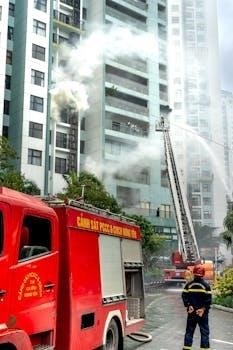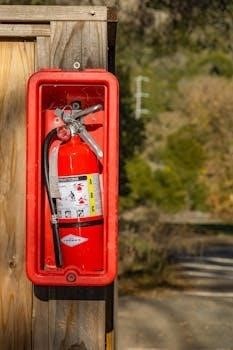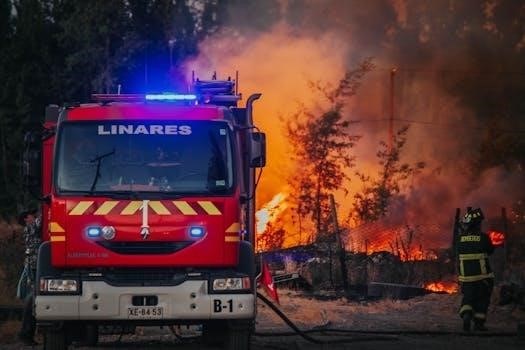Hazardous materials pose significant risks, necessitating specialized fire protection. Understanding these risks is crucial for safety. The proper handling, storage, and transportation of chemicals are vital. Effective fire prevention programs are essential. This guide addresses these issues, drawing from resources and standards.
Defining Hazardous Materials
Hazardous materials, often abbreviated as hazmat, encompass a broad spectrum of substances. These materials present considerable dangers due to their physical and chemical properties. They can pose risks to human health, the environment, and property if not managed correctly. Defining hazmat involves categorizing these substances based on their inherent dangers. This classification is critical for implementing appropriate safety measures. It is essential to recognize that these materials can be solids, liquids, or gases. Each form possesses unique fire-related hazards. Understanding the distinctions between flammable, combustible, and reactive substances is fundamental. Proper identification and labeling are vital components of this process. This ensures that emergency responders can take the correct action. This definition also includes biological and radiological materials. These require specific protocols, exceeding general fire safety practices. Therefore, a comprehensive definition is crucial for effective risk management.
Importance of Specialized Fire Protection
Specialized fire protection for hazardous materials is paramount due to the unique risks they present. Unlike ordinary fires, those involving hazardous materials can exhibit unpredictable behavior. They may react violently, produce toxic fumes, or spread rapidly. Standard firefighting techniques are often inadequate and can even exacerbate the situation. Specialized training and equipment are necessary to handle these incidents safely. This includes understanding the specific properties of the involved materials. It also requires the use of appropriate extinguishing agents. The goal is to prevent escalation and minimize harm to people, property, and the environment. Effective specialized fire protection programs integrate hazard identification, risk assessment, and emergency planning. Furthermore, these plans must be regularly reviewed and updated to reflect the changing environment. The economic consequences of uncontrolled hazardous material fires can be substantial. Therefore, investing in specialized protection is both a safety and economic imperative. It ensures a more effective and safer response.

Key NFPA Documents for Hazardous Materials
Several NFPA documents provide critical guidance. These standards cover hazardous chemical data, fire hazards of flammables, chemical reactions, and hazard identification for emergency responders. These documents are essential tools for fire protection.
NFPA 49⁚ Hazardous Chemicals Data
NFPA 49 serves as a foundational resource, providing crucial data on the hazardous properties of various chemicals. This standard is essential for understanding the potential risks associated with different substances. It details physical and chemical characteristics that influence fire behavior and reactivity, aiding in risk assessment and prevention planning. The data in NFPA 49 helps in categorizing chemicals, which directly impacts storage, handling, and emergency response procedures. It outlines specific hazards related to flammability, toxicity, and reactivity, giving safety professionals and first responders the information necessary to make informed decisions. This information is indispensable for creating effective safety protocols, ensuring the protection of personnel and the environment. Proper utilization of NFPA 49 can mitigate the risks associated with hazardous chemicals, leading to safer workplaces and communities. By referencing this document, stakeholders can develop appropriate strategies for fire prevention and emergency response, based on the specific properties of the chemicals involved. The document’s detailed chemical data enhances the safety of those who handle, store, or may be exposed to these materials.
NFPA 325⁚ Fire Hazard Properties of Flammable Liquids, Gases, and Volatile Solids

NFPA 325 is a critical standard that specifically addresses the fire hazard properties of flammable liquids, gases, and volatile solids. This document offers detailed information regarding the characteristics of these substances, such as their flash points, ignition temperatures, and flammability ranges, which are vital for preventing fires and explosions. It provides guidance on how these materials behave under different conditions and their potential for igniting or contributing to a fire. The standard helps in identifying the risks associated with various flammable materials, aiding in the selection of appropriate storage, handling, and fire suppression methods. It emphasizes the importance of understanding the unique properties of each substance to mitigate hazards effectively. NFPA 325 serves as an essential reference for fire safety professionals, emergency responders, and anyone working with or near flammable materials. Its comprehensive data ensures that appropriate preventative measures can be implemented, reducing the likelihood of fire incidents. The standard also plays a crucial role in developing effective emergency response plans by providing a clear understanding of the potential fire hazards involved.
NFPA 491⁚ Guide to Hazardous Chemical Reactions
NFPA 491 serves as a vital guide for understanding the potential for hazardous chemical reactions. This standard offers crucial insights into how different chemicals might react when mixed or exposed to specific conditions. It details a wide range of possible reactions, including those that could lead to fires, explosions, or the release of toxic substances. The guide emphasizes the importance of identifying incompatible chemicals to avoid dangerous situations. It is an indispensable resource for chemical handling, storage, and transportation, providing guidance on safe practices to prevent accidental reactions. NFPA 491 includes data on various chemical combinations and the potential risks involved, helping users make informed decisions about chemical management. This document assists in the development of emergency response plans by highlighting potential hazards and the appropriate mitigation strategies. By providing comprehensive data on chemical reactivity, NFPA 491 contributes significantly to workplace safety and environmental protection. It enables professionals to understand and anticipate the consequences of mixing or exposing chemicals to different factors, thus preventing potential disasters and ensuring a safer working environment. The information in this guide is crucial for anyone working with chemicals to maintain safe operations.
NFPA 704⁚ Identification of Hazards for Emergency Response
NFPA 704 is a crucial standard that provides a system for identifying the hazards of materials for emergency response personnel. This system uses a diamond-shaped symbol, often referred to as the “fire diamond,” which is divided into four colored sections, each representing a specific type of hazard. The blue section indicates health risks, the red section indicates flammability, the yellow section indicates reactivity, and the white section indicates special hazards. Each section is assigned a numerical rating, ranging from 0 to 4, with 0 indicating minimal hazard and 4 indicating extreme hazard. This universally recognized system enables emergency responders to quickly assess the risks associated with a material and take appropriate actions. It is essential for ensuring the safety of firefighters, paramedics, and other first responders. NFPA 704 is widely used in industrial, commercial, and laboratory settings to label containers and storage areas. This visual system helps to reduce response time and improves the effectiveness of emergency operations. The hazard diamond is a vital tool for conveying critical information quickly and efficiently, thus preventing potential disasters and protecting the well-being of those involved. This standard is a key component in hazardous materials management and emergency preparedness.

Understanding Fire Hazards and Prevention
Understanding fire hazards is crucial for prevention; This involves identifying the properties of hazardous materials. Implementing effective fire prevention programs is essential. OSHA standards provide a framework for safety. Proper classification and storage are key to mitigating risks.
Fire Prevention Programs and OSHA Standards
Effective fire prevention programs are the cornerstone of safety in environments dealing with hazardous materials. These programs are not merely a suggestion, but often a regulatory requirement, particularly under OSHA standards. OSHA mandates specific protocols for fire prevention, including regular inspections, proper storage of flammable substances, and the implementation of control measures to minimize ignition sources. A robust fire prevention program should include employee training on recognizing potential fire hazards, the proper use of fire suppression equipment, and emergency response procedures. Furthermore, it is vital to have a clearly defined chain of command and communication system during emergencies. These programs must also incorporate risk assessments that identify potential weak points in the fire safety infrastructure. Moreover, these assessments should be periodically reviewed and updated. Adhering to OSHA standards and developing a comprehensive fire prevention strategy is crucial for the safety of employees and the protection of property. The standards emphasize a proactive approach to fire safety, moving beyond mere compliance towards a culture of safety awareness and prevention, especially when dealing with hazardous materials.
Classification of Hazardous Materials and Their Properties
Understanding the classification of hazardous materials is fundamental to effective fire protection. These materials are categorized based on their inherent dangers, encompassing flammability, toxicity, reactivity, and corrosivity. Flammable materials, such as liquids, gases, and certain solids, readily ignite and sustain combustion. Toxic substances pose health hazards, while reactive materials can undergo violent chemical reactions, often when exposed to specific conditions or other substances. Corrosive materials can cause damage to skin, eyes, and other tissues. Each category presents unique challenges for fire safety. The properties of a hazardous material, including its flashpoint, ignition temperature, and explosive range, dictate the appropriate fire prevention and suppression techniques. Proper classification enables first responders to recognize the specific dangers involved in a fire incident, allowing for informed tactical decisions. This systematic approach is key to mitigating risks and controlling hazardous materials fires effectively. By understanding these properties, effective fire protection strategies can be developed and implemented. Furthermore, the properties of a material can also determine safe storage and handling methods. Hence, this classification process is critical in minimizing risks and ensuring safety.

Accessing and Utilizing Resources
NFPA codes and standards are crucial resources, often available online. These resources aid in understanding hazardous materials. Accessing free PDF downloads of fire protection guides is beneficial. Utilizing these resources enhances safety and preparedness for emergencies.
Availability of NFPA Codes and Standards Online
The National Fire Protection Association (NFPA) recognizes the critical importance of readily available information for fire safety and, as part of its commitment to enhancing public safety, provides many of its codes and standards online, free of charge, to the public. This initiative ensures that individuals, professionals, and organizations can easily access the essential guidelines needed for effective fire protection and prevention, particularly when dealing with hazardous materials. These online resources are invaluable for understanding the specific requirements and recommendations related to various materials and situations, facilitating better decision-making and implementation of safety measures. The digital accessibility of these documents promotes broader awareness and compliance with safety protocols, contributing significantly to the overall goal of reducing fire incidents and protecting lives and property. The NFPA’s online portal serves as a central hub for accessing these vital resources, making it easier for anyone to stay informed and up-to-date with the latest standards in fire protection. This availability is particularly crucial when dealing with hazardous materials, where precise knowledge and adherence to best practices are paramount. The ability to quickly reference these standards online is a major benefit in emergency situations and daily safety management.
Where to Find Free PDF Downloads of Fire Protection Guides
Locating free PDF downloads of fire protection guides, particularly those related to hazardous materials, often requires a strategic approach. While the NFPA provides online access to many of its standards, direct PDF downloads of comprehensive guides may sometimes be available through various platforms. ResearchGate is one such resource, where research publications, including some fire protection guides, can be found and sometimes downloaded. Additionally, some universities, governmental agencies like OSHA, or specialized safety organizations may host free PDF versions of relevant guides or excerpts from them on their websites, so it’s beneficial to explore these sources. Another avenue is to search library archives or digital repositories. Be sure to verify the legitimacy of download sites and the content’s accuracy before using any materials obtained. It’s also important to check if the documents are up-to-date since fire safety regulations and best practices are subject to periodic revisions, so always use the most recent edition whenever possible. Always prioritize official sources or reputable providers to ensure you are accessing accurate and reliable information for your fire protection needs. Remember that the most comprehensive and authoritative sources for fire protection guidelines are the official publications of the National Fire Protection Association, so that’s always a good place to start.

Leave a Reply
You must be logged in to post a comment.